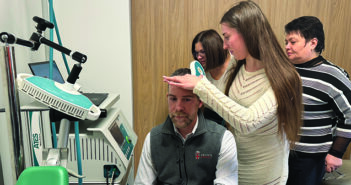The CMO of CVS wants to improve health care access.
We may not think of CVS as a health care company when we’re shopping for snacks and shampoo while filling a prescription, but in fact it’s the largest such company in the US. It encompasses insurance (Aetna), a pharmacy benefit manager (Caremark), and local care providers (HealthHUBs).
Internal medicine physician Sreekanth Chaguturu ’99 MD’04 joined Woonsocket, RI-based CVS in September as chief medical officer. His new role is a variation on a theme that’s emerged over his career: addressing shortcomings in the delivery of care to increase access and quality.
It began at Brown, when Chaguturu spent a year in South India at an HIV referral center as part of an NIH-sponsored study on the role of antiretroviral medications in resource-limited settings. “I became interested not only in questions of science, but in the policy question: how do you even design a health care system to deliver these medications?” he says.
After four years at McKinsey & Company working with international health ministries and other clients around optimizing health systems, he joined Boston-based Partners HealthCare, which had recently been selected to become a pioneer accountable care organization (ACO).
“In 2012, we only had the conceptual papers on what an ACO was,” he recalls. “The question was how to implement that.” Chaguturu delved into negotiations with payers around risk contracts, and was responsible for building clinical programs around certain populations—specifically, the 5 percent of patients who accounted for one-fifth of medical costs, among other targets.
Through implementation of a new care plan, “we were able to reduce hospital admissions by 20 percent, ER visits by 20 percent, and save $2.65 for every dollar invested,” he says.
But most importantly, mortality decreased by 4 percent. “We were most proud of that,” says Chaguturu, who has practiced internal medicine at Massachusetts General Hospital for 12 years.
Over the years at Partners, Chaguturu says he had the opportunity to improve quality and reduce costs in almost every area of health—except for pharmaceutical spending. “It’s one area that health systems aren’t well positioned to address,” he says. “It’s a different set of actors.”
Now he has that chance. Even as he strives to achieve work-life balance—Chaguturu and his wife, Megan Hardin, MD, a clinical research director in the pharmaceutical industry, live with their children, Rohan, 4, and Mira, 3, in the Boston suburbs—his new challenges are some of the most pressing of our time: “ensuring that we have an understanding of the pipeline of medications, getting them into the hands of patients who need them, and making sure we have the quality improvement and cost-containment initiatives for where the industry is headed.”
For example, Chaguturu says, “We are increasingly going to see more gene therapies.” These may be important treatments for many diseases for which there currently is none. He hopes that Zolgensma, a new gene therapy for spinal muscular dystrophy manufactured by Novartis that costs $2.1 million for a single infusion, is an outlier. But Chaguturu’s team’s research suggests that gene therapies in development will be expensive, so they’re studying how to create the right payment models to make them accessible to patients.
His team is also reviewing digital therapeutics—apps and hardware with clinically validated efficacy for anxiety or diabetes, for example—to figure out how to pay for them. There are hundreds of these apps and it takes a great deal of due diligence to distinguish the signal from the noise, Chaguturu says. “Some of these therapeutics actually do work,” he adds.
“Here and now, there are new technologies and new players—big box stores, retail pharmacies, tech companies like Facebook, Google, and Amazon—that have not traditionally been in health care,” Chaguturu says. “Physicians play a critical role in connecting the dots and making sense of this Byzantine world of health care so that it makes sense to patients.”




